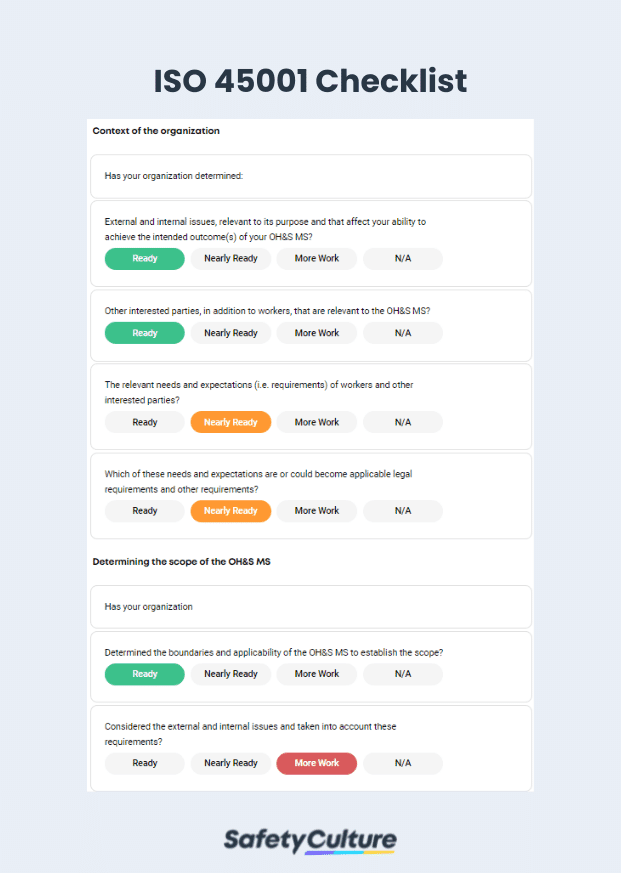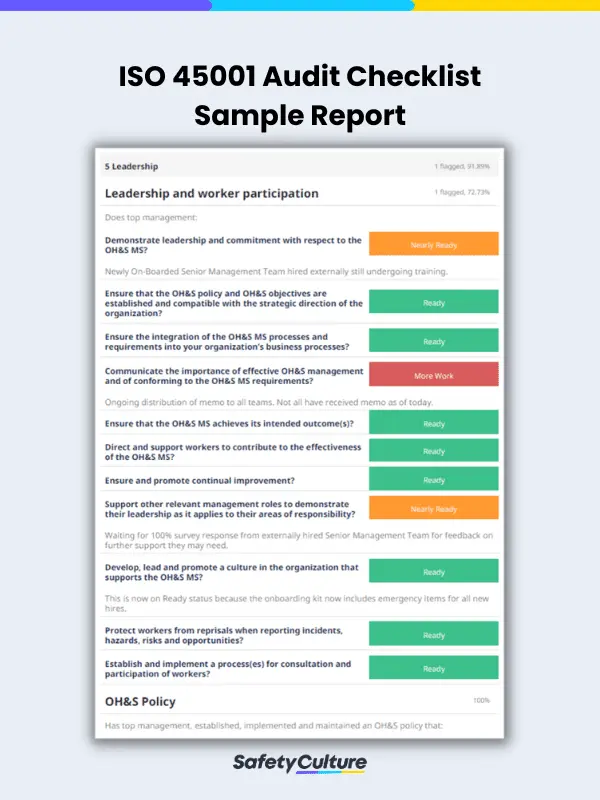What is an ISO 45001 Audit Checklist?
A general ISO 45001 audit checklist template is a tool used to guide an organization when assessing its OH&S management system and determining how aligned it is with the ISO 45001 standard. Also, this checklist can be used by companies when preparing for ISO certifications by covering relevant ISO 45001 audit questions based on its key clauses.
Why Use a Checklist for Conducting ISO 45001 Audits
Using a checklist for conducting ISO 45001 audits can be extremely beneficial for a number of reasons, including the following:
- Ensures comprehensive coverage – This checklist covers all the key ISO 45001 requirements of the standard, which ensures that no important aspect is missed during the audit, making it comprehensive and accurate.
- Increases efficiency – A pre-defined list of questions and requirements can help the auditor to move through the audit process logically, more quickly, and with greater ease. This can help to save time and resources, allowing the auditor to focus on areas of greater concern or interest.
- Improves communication – A checklist also helps keep all stakeholders involved in the audit process. By having a clear understanding of what is being audited and how the process works, communication between the auditor and the organization can be improved, leading to more effective collaboration.
What to Include in an ISO 45001 Audit Checklist
The checklist covers the 7 clauses of the ISO 45001 standard, grouping them into these sections:
- Context of the organization
- Leadership
- Planning
- Support
- Operation
- Performance evaluation
- Improvement
To further guide those who will use the checklist on how these sections must be audited, here are the key areas that should be present:
- Leadership and worker participation – ensuring that top management is committed to providing a safe and healthy workplace and that workers are involved in the development, implementation, and continual improvement of the system
- Hazard identification, risk assessment, and control – identifying hazards, assessing risks, and implementing controls to eliminate or minimize risks
- Objectives, targets, and performance indicators – setting measurable objectives and targets for the OH&S management system, as well as monitoring and measuring performance against those objectives and targets
- Communication, participation, and consultation – ensuring that there are effective channels of communication for workers to report health and safety concerns and that they are consulted on matters related to OH&S
- Performance evaluation – conducting internal audits of the OH&S management system and reviewing performance data to identify opportunities for improvement
Creating One For Your Organization
Creating an ISO 45001 audit checklist involves several steps to ensure that all necessary areas are covered. Here are some key steps you can follow:
- Decide which parts of the organization and which processes will be audited. This will help you to determine the specific areas that need to be included in the checklist.
- Review the ISO 45001 standard and identify the requirements that are relevant to the scope of the audit. These should form the basis of your checklist.
- Organize the checklist by grouping requirements into categories such as leadership and worker participation, hazard identification and control, legal and other requirements, and so on.
- For each requirement, include specific and easy-to-understand questions to help you assess whether the organization is meeting the requirement.
- Prioritize the checklist items based on their importance to the organization’s OH&S management system.
- Test the checklist by conducting a trial audit to help you identify any gaps in the checklist and refine it before using it formally.
How to Prepare for ISO 45001:2018 Certification
Below are steps to get started in achieving certification for ISO 45001:2018:
- Obtain a copy of ISO 45001:2018.
- Identify gaps in the existing OH&S Management System by conducting a gap analysis or readiness test to meet ISO 45001:2018 requirements using an ISO 45001 audit checklist.
- Develop an implementation plan using the Plan-Do-Check-Act (PDCA) cycle.
- Define your organization’s competency and training requirements for ISO 45001:2018.
- Ensure competence needs are met and all parties involved are kept in the loop.
ISO 45001 Audit Report Sample
Now that you know the most important components of an effective ISO 45001 audit checklist and how to create one for your organization, you must also know what it looks like as a completed report. Below is an example of a filled-out ISO 45001:2018 audit checklist.
FAQs About ISO 45001
ISO 45001 is valuable for organizations of all sizes and industries because the standard aims to help in developing a safe working environment. Below are some benefits of certifying for ISO 45001:
- Reduces workplace injury and illness
- Boosts productivity and lowers insurance costs
- Gives you a competitive advantage as you publicly demonstrate your commitment to safety and continuous improvement
Conducting an internal ISO 45001 audit can be summarized into 5 steps:
- Assign an internal auditor.
- Develop a consistent internal audit program.
- Use an ISO 45001 audit checklist.
- Assess findings and generate a comprehensive report.
- Create and implement corrective actions.



